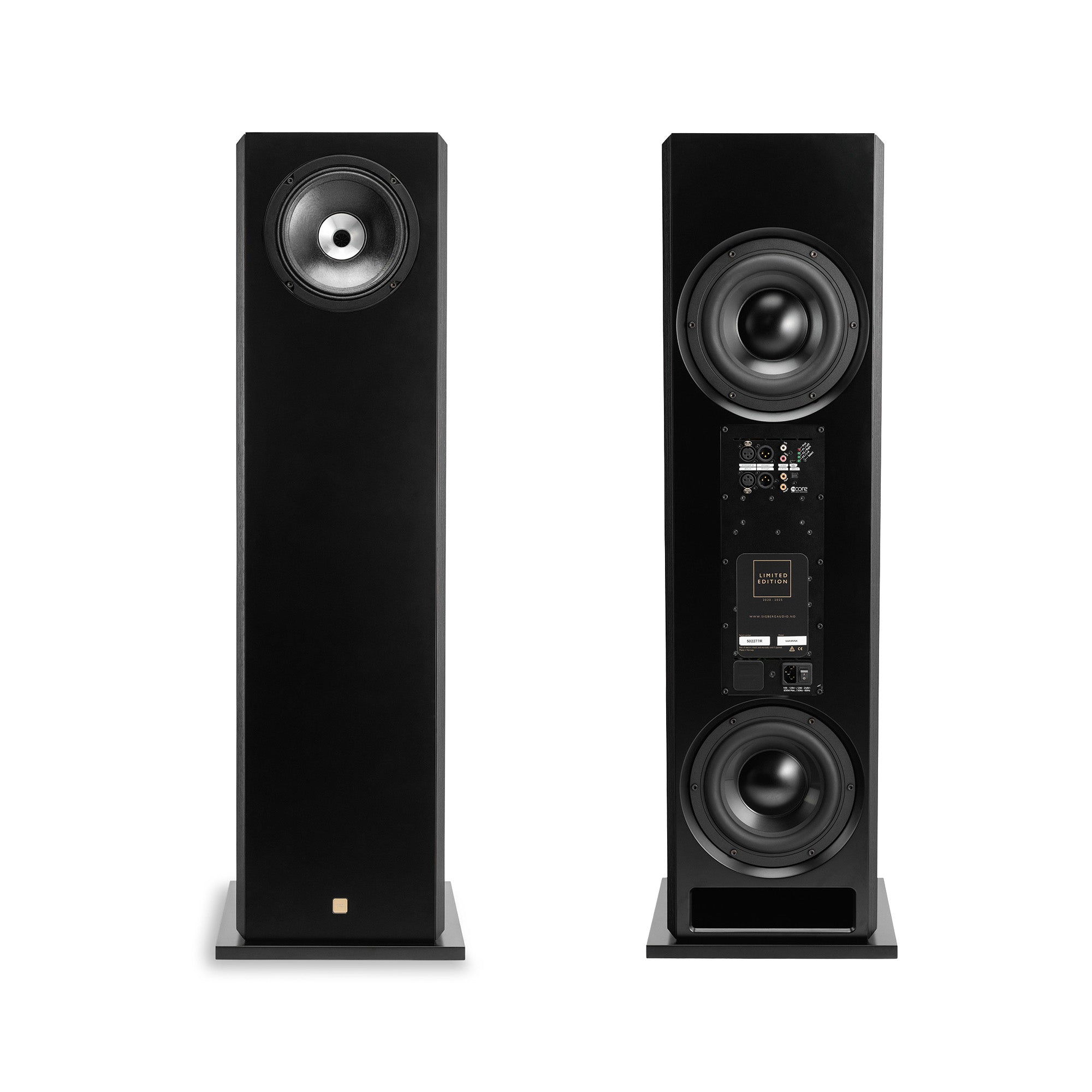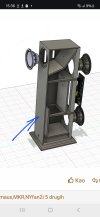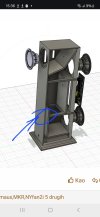Thanks for sharing. Any concern with cooling of the Hypex in that small sealed chamber? Even with a fan they do get warm. I really wish Hypex had a non-plate mount option with Fusion series (separate enclosure with proper venting). I know they were designed with thermal concerns in mind for plate mount, but I have to believe there is some impact to performance/lifetime.A look inside, for those who are curious.Note that this a development model, not the finalized model for production. So all details are not present / necessarily 100% accurate.
View attachment 430239
-
Welcome to ASR. There are many reviews of audio hardware and expert members to help answer your questions. Click here to have your audio equipment measured for free!
You are using an out of date browser. It may not display this or other websites correctly.
You should upgrade or use an alternative browser.
You should upgrade or use an alternative browser.
Sigberg Audio Saranna (fullrange, cardioid active floorstander) development thread
- Thread starter sigbergaudio
- Start date
- Thread Starter
- #522
Thanks for sharing. Any concern with cooling of the Hypex in that small sealed chamber? Even with a fan they do get warm. I really wish Hypex had a non-plate mount option with Fusion series (separate enclosure with proper venting). I know they were designed with thermal concerns in mind for plate mount, but I have to believe there is some impact to performance/lifetime.
The chamber isn't really that small. The rear baffle is 32mm thick, and the amp is only about 50mm deep, so most of the chamber is open space above the amp. Also, the plate is designed to transfer heat to the outside. So that the plate is warm to touch is a good sign, that means it is working as intended. We've done long term internal temperature measurements of previous designs with similar sized chambers, using probes inside the chamber. The temperatures are not alarming at all.
Again, I know they are designed for this, and well understand the mount plate itself is a heat sink, and yes it works. But still I prefer a “separates” option. Of course I understand the attraction of some (many?) to have a speaker fully self contained, especially the younger “lifestyle” product crowd, but I am not one of them. Anyway, if you want to use Fusion, ya got no choice. They are superb products (though as we have discussed prior, DSP SW is clunky), just again would like to have an external option.The chamber isn't really that small. The rear baffle is 32mm thick, and the amp is only about 50mm deep, so most of the chamber is open space above the amp. Also, the plate is designed to transfer heat to the outside. So that the plate is warm to touch is a good sign, that means it is working as intended. We've done long term internal temperature measurements of previous designs with similar sized chambers, using probes inside the chamber. The temperatures are not alarming at all.
- Thread Starter
- #524
Again, I know they are designed for this, and well understand the mount plate itself is a heat sink, and yes it works. But still I prefer a “separates” option. Of course I understand the attraction of some (many?) to have a speaker fully self contained, especially the younger “lifestyle” product crowd, but I am not one of them. Anyway, if you want to use Fusion, ya got no choice. They are superb products (though as we have discussed prior, DSP SW is clunky), just again would like to have an external option.
Yes. Anyway, here's a better view of the available space in the amp chamber.
- Thread Starter
- #526
Again not wanting to troll but to talk about the product and their possible improvements.
Looking at this picture"bad resonance" could occur here on this long side.
Maybe extend or add ribs to that part?
Not sure if I understand why you would like to extend it, that would move the resonance lower in frequency, that is not desirable. I might be misunderstanding what you mean here.
Beyond that there are generous dampening material to reduce resonances. The bottom of the bass chamber is in practice below the lower bass driver, not at the very bottom of the speaker, due to the port being part of the cabinet. There is a peak outside of the passband of the bass drivers if you measure inside the port. It is not visible on the summed response.
You misunderstood me, not extending the bass port to lower frequencies.Not sure if I understand why you would like to extend it, that would move the resonance lower in frequency, that is not desirable. I might be misunderstanding what you mean here.
Beyond that there are generous dampening material to reduce resonances. The bottom of the bass chamber is in practice below the lower bass driver, not at the very bottom of the speaker, due to the port being part of the cabinet. There is a peak outside of the passband of the bass drivers if you measure inside the port. It is not visible on the summed response.
I didn't even think about bad port resonance, and there probably won't be any considering the bass port is on the back and as you said is additionally damped.
What I meant was the front panel(baffle).
Which has no stiffening ribs except for the two above where the driver stand.
So that front side(baffle) could bad resonate considering that the only stiffener in the middle holds the inner wall of the port chamber.No baffle embarrassed at the middle!
I hope I succeeded in explaining.
Yes, the port is not visible well, but it is at the back, under the hypex amplifier I believe?
Attachments
Last edited:
- Thread Starter
- #528
You misunderstood me, not extending the bass port to lower frequencies.
I didn't even think about bad port resonance, and there probably won't be any considering the bass port is on the back and as you said is additionally damped.
What I meant was the front panel(baffle).
Which has no stiffening ribs except for the two above where the driver stand.
So that front side(baffle) could bad resonate considering that the only stiffener in the middle holds the inner wall of the port chamber.No baffle embarrassed at the middle!
I hope I succeeded in explaining.
Yes, the port is not visible well, but it is at the back, under the hypex amplifier I believe?
Hi, yes I misunderstood. Yes, this is a valid point - due to the positioning of the port there is no brace of the baffle in the lower part, and it has been adressed in the production model. There is an additional brace a little more than midway up the baffle panel (safely away from the port) to address this.
- Thread Starter
- #529
Two seconds of video of the Saranna (and the Manta) 
- Thread Starter
- #530
- Thread Starter
- #531
This week we've been to the studio to shoot the Saranna launch trailer! 

- Thread Starter
- #532
A few more on the website

Saranna Full Range Active Floorstander (pair)
Saranna is for you if you want a speaker with: Deep, punchy bass without the need for subwoofers Exceptional clarity and nuance without listening fatigue An immersive and huge soundstage unlike anything you've ever heard. An ability to play loud and uncompressed even in large rooms. The option...
 www.sigbergaudio.com
www.sigbergaudio.com
- Thread Starter
- #534
What sampling rate is used internally?
96kHz?
93.75khz. Hypex (the manufacturer of the DSP) has chosen a somewhat untraditional sampling rate. Their reasoning is as follows:
"The sampling rate is set to 93.75kHz instead of one of the more traditional audio rates. This is specifically done to improve the performance of the SRC chip. An uncommon clock frequency reduces the odds that mix products between the incoming clock and the internal clock fall inside the PLL loop bandwidth of the SRC."
What drivers are used for bass? Are they custom OEM or a generally available model? if so, which one? If custom OEM, what are the specs?View attachment 432941
View attachment 432942
View attachment 432943
A few more on the website

Saranna Full Range Active Floorstander (pair)
Saranna is for you if you want a speaker with: Deep, punchy bass without the need for subwoofers Exceptional clarity and nuance without listening fatigue An immersive and huge soundstage unlike anything you've ever heard. An ability to play loud and uncompressed even in large rooms. The option...www.sigbergaudio.com
- Thread Starter
- #537
What drivers are used for bass? Are they custom OEM or a generally available model? if so, which one? If custom OEM, what are the specs?
This was briefly discussed here : https://www.audiosciencereview.com/...stander-development-thread.49881/post-1791563
Biblob
Addicted to Fun and Learning
- Joined
- Sep 13, 2018
- Messages
- 675
- Likes
- 680
Interesting to see how you have designed the cardioid box! It look very different than most of the ones I've seen, up untill now. It doesn't use a straight area of reflection, but is more of a tilted shape. Could you expand a bit on how you came to this solution?A look inside, for those who are curious.Note that this a development model, not the finalized model for production. So all details are not present / necessarily 100% accurate.
View attachment 430276
And also, how much difference does it make that you don't have vents on the front baffle?
Looks like an awesome loudspeaker
CinamonRolls
Member
- Joined
- Nov 19, 2023
- Messages
- 40
- Likes
- 19
Interesting to see how you have designed the cardioid box! It look very different than most of the ones I've seen,
The enclosure tilts back a little like the SBS.1. That's why the slots look like that.
- Thread Starter
- #540
Interesting to see how you have designed the cardioid box! It look very different than most of the ones I've seen, up untill now. It doesn't use a straight area of reflection, but is more of a tilted shape. Could you expand a bit on how you came to this solution?
And also, how much difference does it make that you don't have vents on the front baffle?
Looks like an awesome loudspeaker
Thank you!
The side ports are straight (if that is what you are referring to), as @CinamonRolls says, the entire enclosure is tilted.
With regards to the front baffle vents on the Manta, they are actually there to trick the coax into "seeing" a more narrow baffle and improve off-axis response. This is not needed on this speaker since the driver is almost as wide as the baffle, and the baffle itself is also more narrow than the Manta.
Similar threads
- Replies
- 0
- Views
- 687
- Replies
- 0
- Views
- 254
- Replies
- 13
- Views
- 2K
- Replies
- 43
- Views
- 5K
- Replies
- 26
- Views
- 6K

